Revelation: Removing the VeilThis revelation was given by God to the Apostle John because we needed to know it.
Part 1
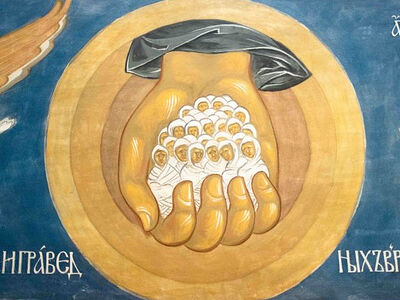
If Christ Is With Us, Death Is DefeatedThe book of Revelation teaches us a lot, especially when we begin to carefully delve into its words, when we see how Christ holds the world in His hands and acts with wisdom in all things.
Part 2
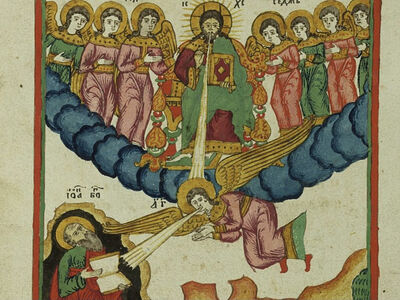
Why Did the Lord Leave Man the Book of Revelation?Only the people of God, the saints, can receive revelations from God, and only they can interpret them, because a revelation, words from God, is given from God, from the Holy Spirit.
Part 3
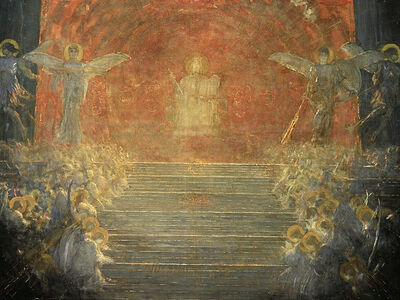
For the Time Is at Hand…We have to understand that God acts outside of time, and the events of Revelation don’t relate only to the end times.
Part 4

Blessed Is He That Readeth…Christ sent the revelation through an angel to His servant the Apostle and Evangelist John, who conveyed the word of God and the testimony of Jesus Christ about what he saw and heard.
Part 5

He Hath Made Us Kings and PriestsA man who is close to God, my dears, truly feels like a king—he has no need of anything. At the same time, he may have absolutely nothing.
Part 6

John, Our Companion in Tribulation, and in the Kingdom and Patience of Jesus ChristOne of the most significant and frequent references to the Holy Trinity is in the text of Revelation.
Part 7
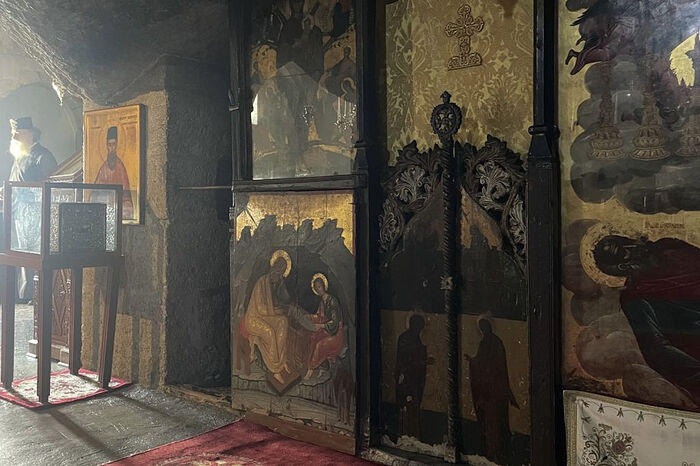
Cave of the Apocalypse, Patmos Island
His head and his hairs were white like wool, as white as snow; and His eyes were as a flame of fire (Rev. 1:14). The Prophet Daniel described the same thing when he saw the Ancient of Days (he saw Christ).
Of course, we shouldn’t think that Christ or God the Father has white hair. Nothing of the sort—because God is spirit. But God appeared in a way that the Apostle John could see this image and describe it as having a profound meaning.
Thus, the Ancient of Days appears, God Himself, who spoke to the Prophets, with the  Holy Prophet Daniel Among the chosen youths Daniel had three friends: Ananias, Azarias and Misail. All four steadfastly preserved their faith in the one true God and together refused to eat the king’s food for fear breaking one of Moses’ laws. They asked their overseer to give them only bread and vegetables, but the overseer was afraid that they would become thin and he would be made to suffer the king’s wrath. Daniel persuaded him to make a test and allow them to observe this regimen for ten days.
Holy Prophet Daniel Among the chosen youths Daniel had three friends: Ananias, Azarias and Misail. All four steadfastly preserved their faith in the one true God and together refused to eat the king’s food for fear breaking one of Moses’ laws. They asked their overseer to give them only bread and vegetables, but the overseer was afraid that they would become thin and he would be made to suffer the king’s wrath. Daniel persuaded him to make a test and allow them to observe this regimen for ten days.
You know that visions from God are always whole, complete—they’re never half-hearted. But in visions from satan, there’s always something missing; they’re not long-lasting, they flicker. Visions from God are long-lasting; there are never any omissions in them, like something missing. Those who see satanic visions always miss something; there’s always something missing in them. They’re short and the images are constantly changing. The works of God have a duration, and they’re completed, therefore the Apostle John describes a vision here that he beheld for an extended period of time. His voice was like the sound of many waters, like a roaring sea filling everything with sound; a voice was heard speaking to him. Imagine this amazing vision that the 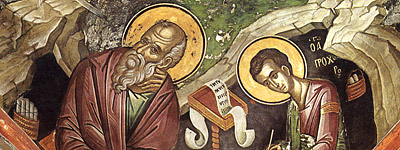 St. John the Theologian Apostle John beheld!
St. John the Theologian Apostle John beheld!
And He had in His right hand seven stars: and out of His mouth went a sharp twoedged sword: and His countenance was as the sun shineth in His strength (Rev. 1:16). The double-edged sword coming from the mouth of Christ symbolizes the word of God that runs through the human heart. His face shone like the sun in its full strength at the moment. Such an amazing vision was revealed to the Apostle and Evangelist John the Theologian. And then Christ explains to him what he saw.
In verse 17, he says: And when I saw Him, I fell at His feet as dead. And He laid His right hand upon me, saying unto me, Fear not; I am the First and the Last (Rev. 1:17). What person could see and withstand this? The Apostle refers here to the right hand of God. Therefore, we cross ourselves with our right hand, which is considered the hand of blessing.
The Apostle felt reassured as the Lord placed His right hand on him and said, “Fear not; I am the First and the Last.” God removes man’s fear, for His works contain no fear. Though fear may briefly touch our nature, God takes it away. When God acts, there is no room for fear; there is only love and peace in the soul. The Lord is everything— the Beginning and the End. He is the One who lives, who was once dead but now lives for eternity, holding the keys to death and hell in His hands.
The Almighty God became man for us, offering Himself in love so that we may have a relationship with Him devoid of fear. If we love God and see Him as our Father, nothing, not even death, can shake us when we are united with Him. In Revelation, He instructs the Apostle to write down all that he sees, including the mystery of the seven stars in His right hand and the seven golden lampstands, which symbolize the angels and bishops of the seven Churches, respectively.
The bishops of the Churches are like angels of God, tasked with conveying His will and teaching His word. They hold a great responsibility, as Christ’s words to them are crucial. As we move into chapter 2, we see Christ addressing the angel of the Church of Ephesus, emphasizing His presence among the Churches and the responsibility that falls upon the clergy to lead their flocks in His ways. In writing to the bishop of the Ephesian Church, the One who holds stars in His right hand reminds us of the Old Testament phrase “Thus saith the LORD,” emphasizing that only God can speak in this way. This refutes the belief of Jehovah’s Witnesses that Christ is not God, as in Revelation, Christ speaks and reveals Himself in the same manner as God did in the Old Testament. The Lord’s presence among the seven Churches is described as the greatest miracle, highlighting the divine establishment and preservation of the Church despite its flaws and challenges. The bishop is commended for his works, patience, and discernment in dealing with false apostles, but is also cautioned for losing his initial fervor and love for God. This serves as a reminder for all believers to reflect on the zeal and love for God they had in their youth, and to guard against allowing external factors to diminish their devotion. In verse 5, Christ continues to admonish, urging the reader to remember where they have fallen from and to repent and return to their first works. Failure to do so will result in consequences, as Christ warns that He will remove their candlestick unless they repent. It is a call to return to their initial love and faith.
To go back to God, one must repent and revisit the actions and behaviors that led them astray. This may involve returning to practices such as abstinence, charity, or hard work, depending on the individual’s struggles. Reflecting on where one has strayed and acknowledging the reasons for their departure from their first love is essential in the process of repentance.
Repentance involves a change in mindset, a return to the first works done in the beginning, and a genuine sorrow for not being able to continue those practices. God may send challenges and trials as a wake-up call for individuals who fail to repent, urging them to reflect on their past actions and return to their initial state of faith and love.
Despite the warnings and calls for repentance, there is still hope for those who overcome sin and temptation. God promises to reward those who overcome with a taste of the Tree of Life, symbolizing a return to a state of grace and closeness to God. It is a reminder that through repentance and perseverance, individuals can find their way back to God and experience His mercy and grace.
Source link

